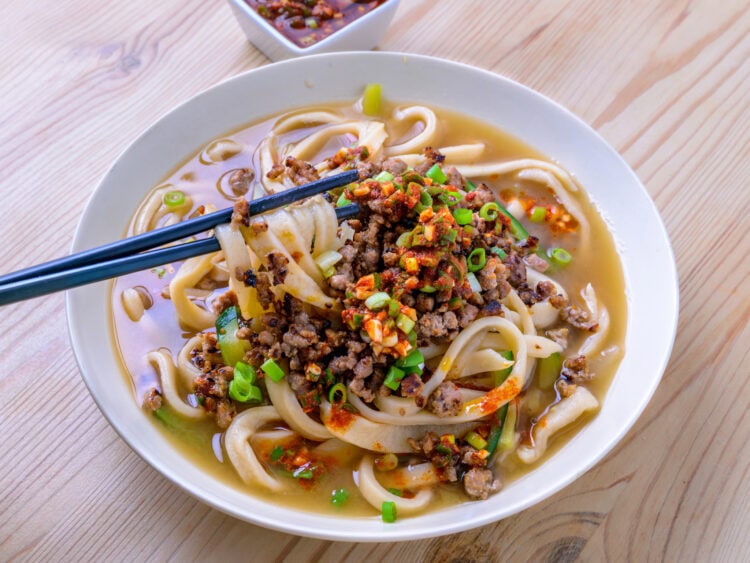A delicious Korean knife-cut noodle soup, served in an anchovy broth with various toppings and spicy sauce.
The first thing you notice is the mist. A veil of fragrant noodle steam condenses on the window as summer rain “patters on the awning. Diners lean over bowls that gurgle like small hot springs. They practice”iyeol chiyeol: the Korean belief that one chases away dampness by enjoying an equally hot dish.
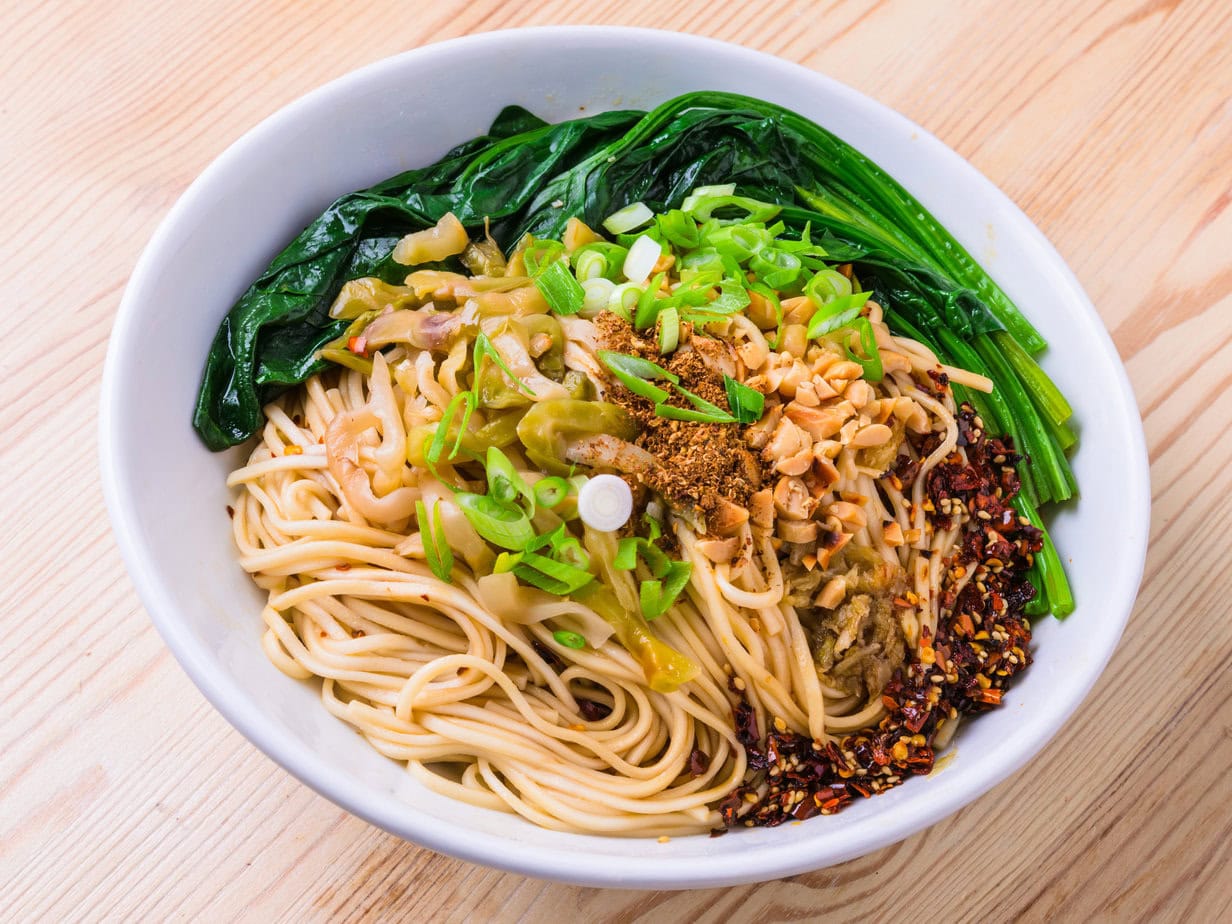
In these bowls lies kalguksu: knife-cut noodles so tender they undulate, bathed in a broth reminiscent of long-simmered chicken. As humble as it may seem, the soup distills centuries of expertise and comfort, offering a history lesson, sip after sip, on how Korea transformed scarcity, ingenuity, and a bit of flour into an edible refuge.
From Royal Treat to Rainy Day Essential
Under Goryeo and early Joseon, wheat was so rare that it was locked in royal granaries. Noodles therefore only appeared on special occasions: weddings, harvest banquets, or dol, that first birthday where noodles symbolize longevity.
In her 1670 classic, Eumsik Dimibang, Lady Jang Gye-hyang already describes a method for knife-cut buckwheat-wheat noodles, the earliest written trace of the technique that would later give rise to kalguksu. For centuries, the dish remained elitist; its translucent noodles were a demonstration of the cook’s blade skills.
The Korean War disrupted this order. American aid ships unloaded bags of white flour in ports; suddenly, a food once reserved for nobility could feed refugees and the working class. Street vendors improvised portable cauldrons, and in the 1960s, Myeongdong Kyoja opened in Seoul, offering a chicken broth, to which, it’s said, a hint of pork is added, which still attracts long queues today.
In an Authentic Bowl: Noodles, Broth, Toppings
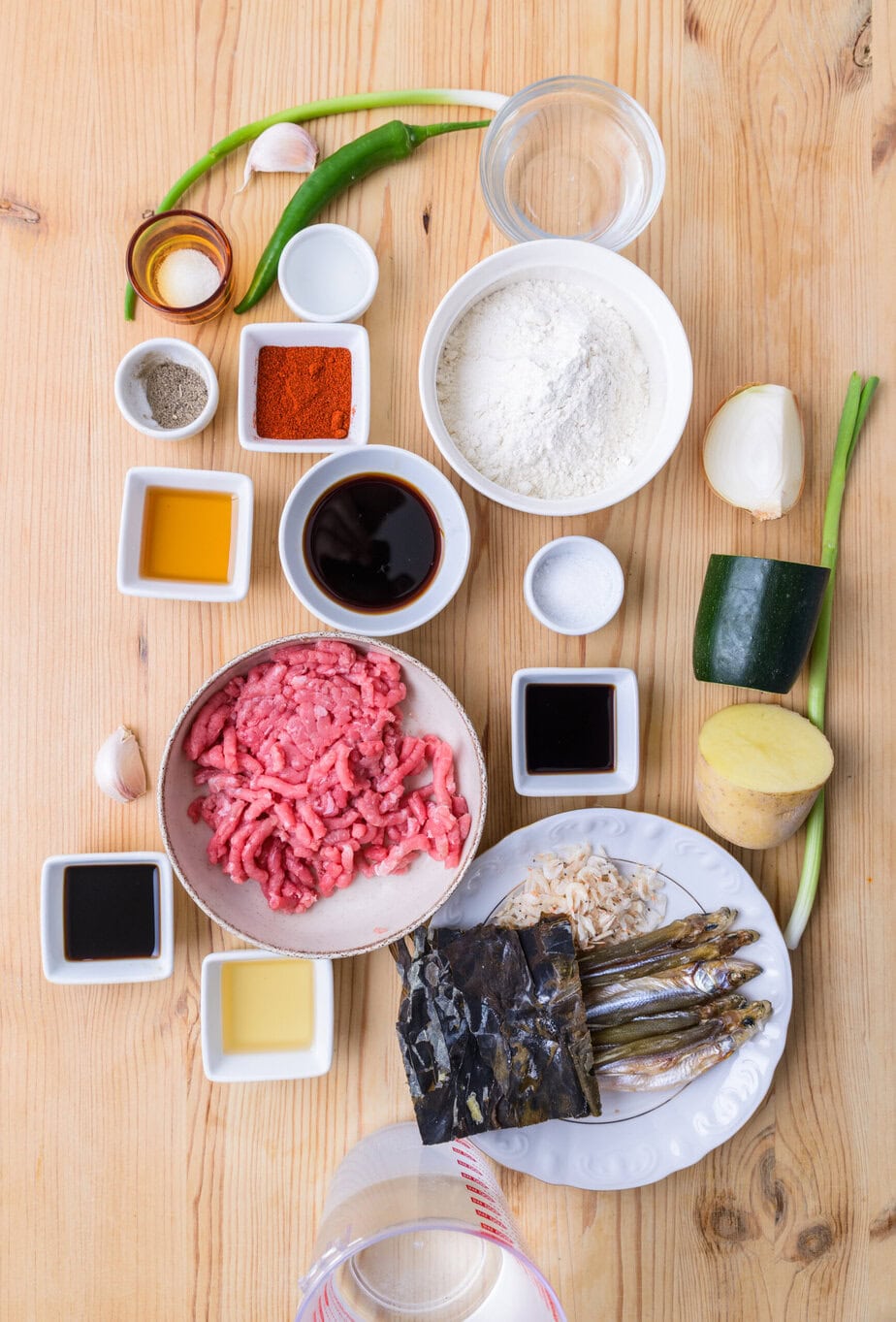
Noodles. True kalguksu noodles are never factory-calibrated. A handful of dough is thinly rolled out, folded, then sliced into 3 to 5 mm ribbons. The irregular edges offer an elastic chew that dry pasta cannot imitate.
Broth. Houses generally fall into two camps. The coastal version simmers dried anchovies and seaweed (kombu) for 20 to 30 minutes, skimming often for a clear liquid; the seaweed is removed quite quickly. Inland kitchens prefer one to two hours of simmering a whole chicken, releasing collagen that adheres to the noodles. In both cases, the seasoning remains subtle: salt, a touch of guk-ganjang; thus allowing the sweetness of the flour to shine through.
Accompaniments. Half-moons of zucchini and potato cubes travel in the broth from start to finish, their starch gently thickening the soup. Clams join the marine version, opening like briny confetti; breast shreds crown the dak kalguksu. The only red allowed is the kimchi served on the side, its cold crunch resetting the palate between sips. Optional but cherished extras: perilla seed powder for a nutty note, seaweed flakes for an ocean flavor, …
Regional Variations of Kalguksu
Travel about 230 kilometers southeast and you’ll reach Andong, where the aristocratic yangban once refreshed themselves with Andong-guksi. The noodles, enriched with soy flour, are rolled almost translucent, then boiled before being sprinkled with cold water for a clean summer bowl. A pinch of seaweed and thin yellow ribbons of egg add a courtly touch.
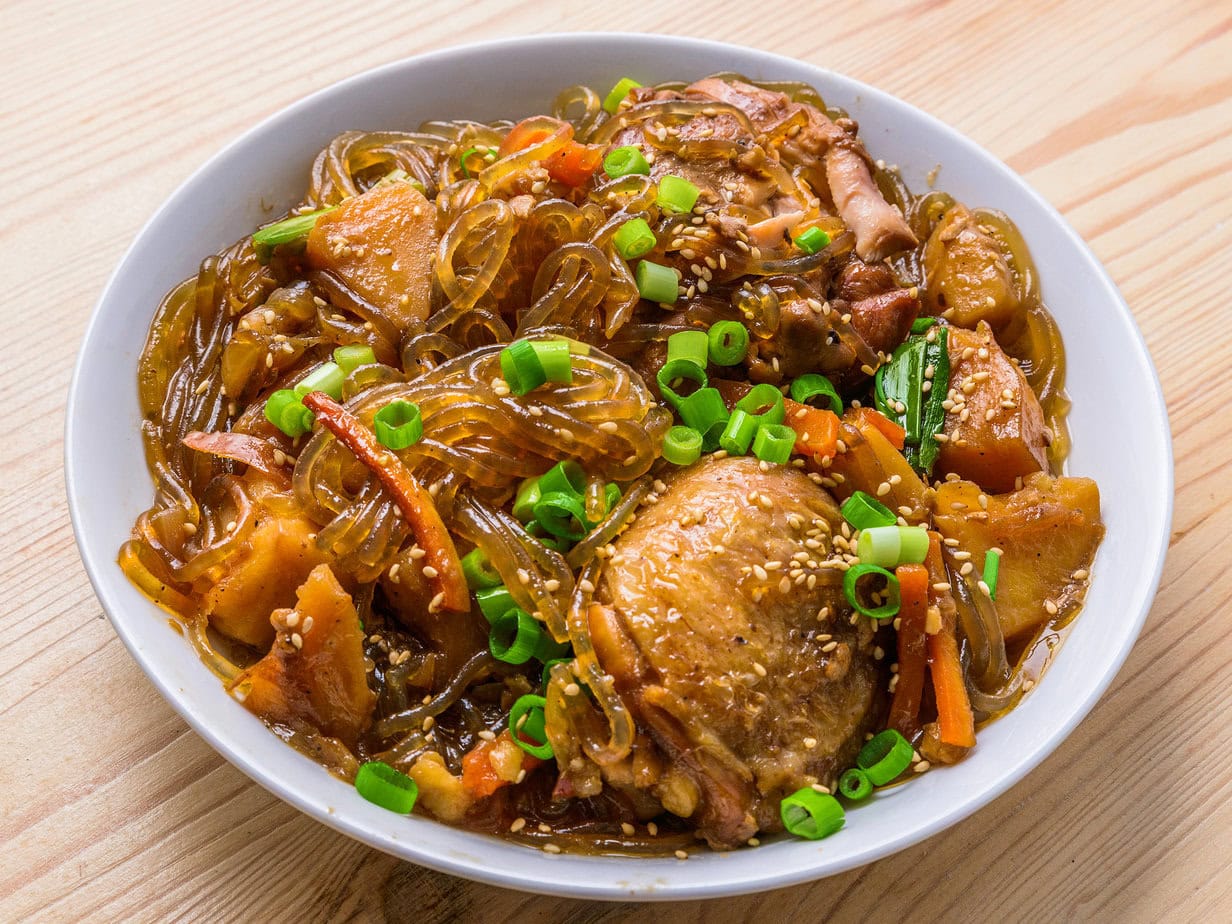
Heading west to Chungcheong, chicken takes center stage. The region’s light broth, sometimes enhanced with a few clams or oysters, inspired the famous bowls of Myeong-dong, proving that urban icons often owe a debt to rural cuisines. Further north, in the sea-mountain terrain of Gangwon, they serve jang-kalguksu, mixing rustic gochujang or doenjang with an anchovy broth for a scarlet soup often accompanied by a splash of icy water kimchi with radish.
Winter in Jeolla heralds pat-kalguksu: wheat noodles floating in a creamy red bean porridge, halfway between a meal and a warm dessert. Further south, windy Jeju marries buckwheat noodles with pheasant broth, a bowl that tastes of basalt and open fields – a reminder that terroir can be served by the ladle.
A few Key Points to Identify a Real Kalguksu
Authentic kalguksu whispers; it doesn’t shout. If the broth assaults you with excess salt or exhales the smell of a bouillon cube, move on. Beware of industrial noodles: they swell and become slimy, just like a soup so thick it coats the spoon.
Innovation has its place: a kimchi-infused broth that tingles or creamy variations that willfully depart from tradition, as long as they’re labeled “modern” so everyone knows it’s an adaptation, not the original matrix. When chefs swap wheat for quinoa flour or flavor the broth with truffle oil, the best continue to honor the heart of kalguksu: handmade noodles, an honest broth, a measured balance.
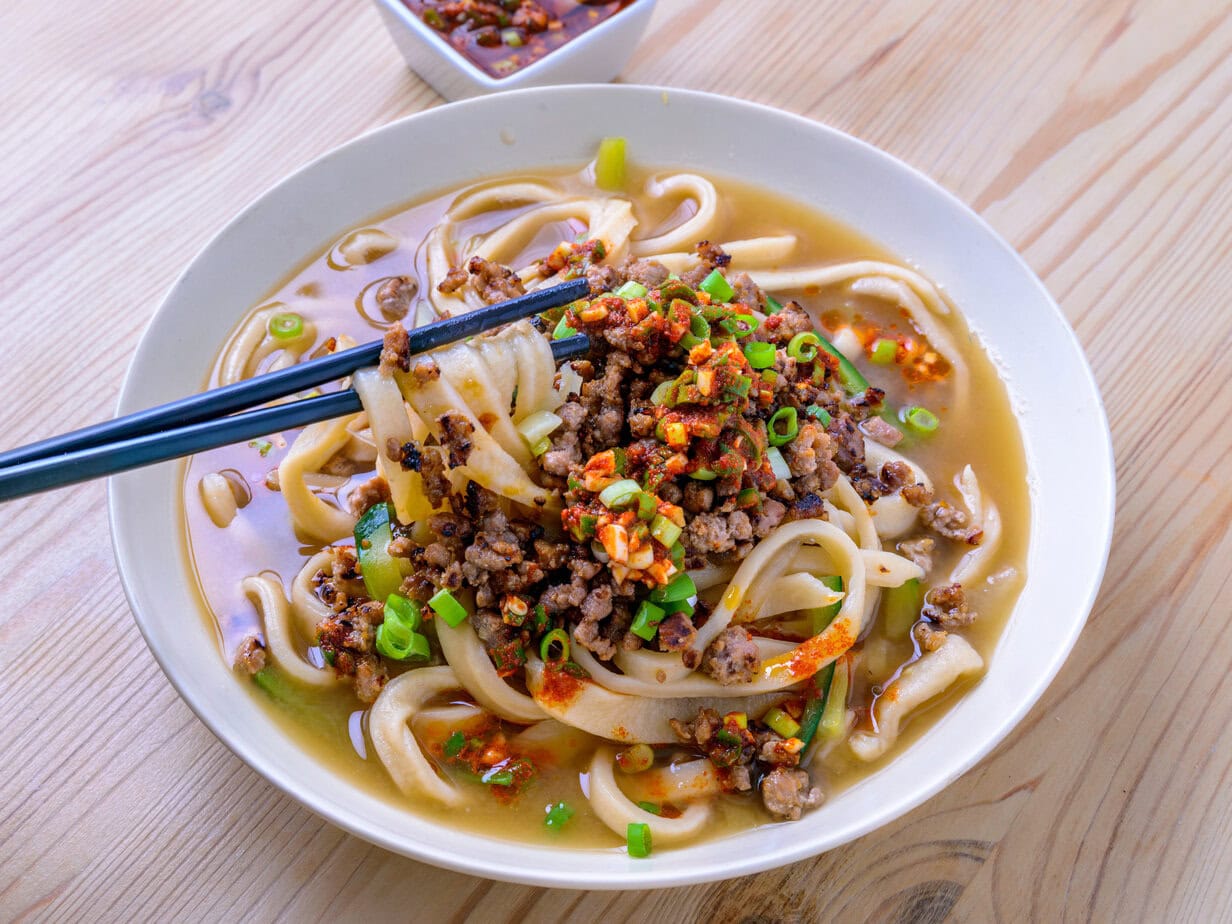
Kalguksu – Korean Noodle Soup
Equipment
Ingredients
Knife-Cut Noodle Dough
- 120 g of all-purpose flour
- 60 ml water
- 0.25 teaspoon salt
Anchovy Broth
- 1 L water
- 7 dried anchovies
- 1 tablespoon small dried shrimp optional
- 1 Piece of kombu about 2 x 3 inches
- 0.5 teaspoon salt
- 1 teaspoon guk ganjang Korean soup soy sauce
Soup Ingredients
- 100 g zucchini or Korean hobak julienned
- 0.25 yellow onion
- 100 g of potatoes julienned
- 1 green onion
Beef Topping
- 85 g of ground beef
- 1.5 teaspoons of mirin
- 1.5 teaspoons light soy sauce
- 0.5 teaspoon garlic chopped
Yangnyeom Ganjang (Green Chili Sauce)
- 1 tablespoon light soy sauce
- 1.5 teaspoons by gochugaru
- 2 teaspoons of green chili chopped
- 1 teaspoon rice vinegar
- 1 tablespoon of green onion chopped
- 0.5 teaspoon sesame oil
- 1 teaspoon garlic chopped
- 1 pinch of sugar
- 1 pinch pepper
Additional Toppings
- Green onions chopped
- Green Chilies thinly sliced
- Garlic sliced
Instructions
Noodle Preparation (Skip if Using Store-Bought Noodles)
- Mix the flour, salt, and water in a bowl “using” a spatula, then form a ball with your hands.120 g of all-purpose flour, 60 ml water, 0.25 teaspoon salt
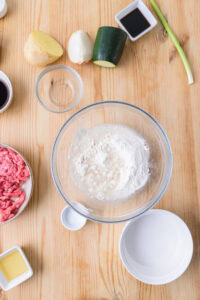
- Gradually add more water until a dough forms, being careful not to overdo it.
- Once the dough is formed, transfer it to a floured work surface and knead about ten times until smooth.

- Cover the dough with plastic wrap or place it in a plastic bag and let it rest for at least 30 minutes, or overnight in the refrigerator.

- Take out the dough, knead it for 2 minutes, then roll it out thinly on a floured surface into a square of about 10 x 10 inches or a rectangle of 8 x 11 inches.
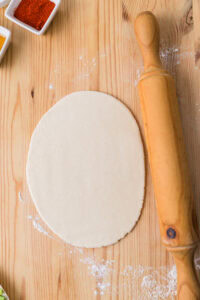
- Dust the surface with flour, fold the dough in layers 4 to 5 times, then gently cut with a knife.
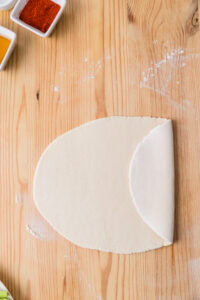
- Immediately separate the cut strips to prevent sticking, dust them with flour, and leave them uncovered until cooking.
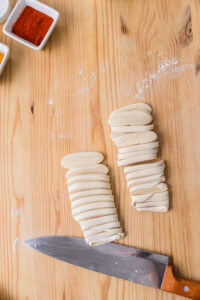
Beef Topping
- Season the ground beef with soy sauce, mirin, and garlic.85 g of ground beef, 1.5 teaspoons light soy sauce, 1.5 teaspoons of mirin, 0.5 teaspoon garlic
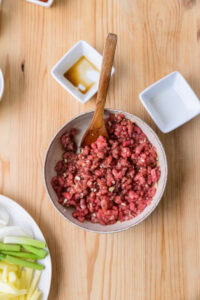
- Heat a non-stick pan over medium-high heat and cook the beef until fully cooked, breaking up the pieces.
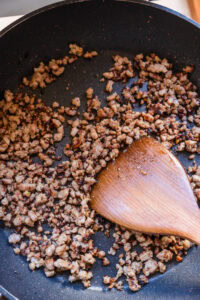
- Set aside to garnish the soup later.
Spicy Sauce (Dadaegi)
- In a bowl, mix the green onions (reserve half for garnish), chopped chilies, and sesame oil.1 tablespoon of green onion, 2 teaspoons of green chili, 0.5 teaspoon sesame oil
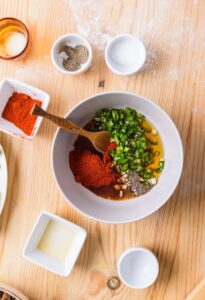
- Then add soy sauce, vinegar, chili powder, sugar, garlic, and pepper, and set aside.1 tablespoon light soy sauce, 1 teaspoon rice vinegar, 1.5 teaspoons by gochugaru, 1 pinch of sugar, 1 teaspoon garlic, 1 pinch pepper
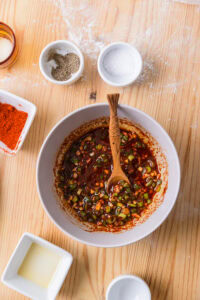
Kalguksu Soup Preparation
- Prepare the noodles if homemade and let them rest.
- In a pot, add water, dried anchovies, kombu, and optionally, dried shrimp.1 L water, 7 dried anchovies, 1 Piece of kombu, 1 tablespoon small dried shrimp
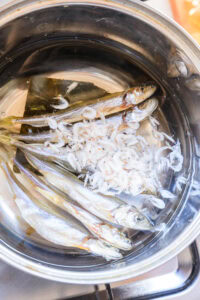
- Simmer uncovered for 30 minutes, then turn off the heat and let it steep.
- Slice the onions, zucchini, and optionally potatoes into julienne strips.0.25 yellow onion, 100 g zucchini or Korean hobak, 100 g of potatoes
- Chop the green onions, garlic, and green chilies.1 green onion, Green onions, Green Chilies, Garlic
- Remove the anchovies and kombu from the broth.
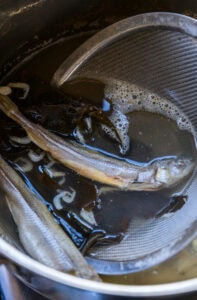
- Bring the broth to a boil, season with soup soy sauce and salt, taste and adjust.1 teaspoon guk ganjang, 0.5 teaspoon salt
- When the broth is boiling, add the onions and simmer for 5 minutes until they become translucent.
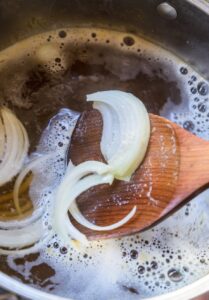
- Return to medium-high heat, add the zucchini and noodles.
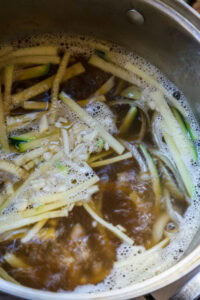
- Add garlic and green onions as garnish now or later.
- Cook for 3 to 5 minutes for homemade noodles, or follow instructions for store-bought noodles.
- Serve the soup and noodles in a bowl, add the spicy sauce separately.
- Garnish with cooked beef, fresh green onions, garlic, and green chilies as preferred.
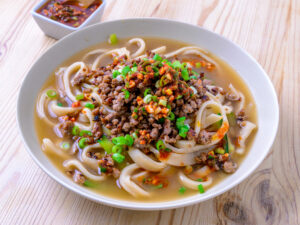
Notes
Nutrition
Culinary sources
- Kalguksu Recipe – MasterClass (2025): comprehensive tutorial on “knife-cut” noodle soup
- World Food – “Kalguksu” (Slow Food): history, terroir, and Slow Food dimension
- “한의학이 말하는 여름철 칼국수의 매력” – Naeway News: benefits according to traditional Korean medicine
- 서울사랑 (municipal magazine): addresses and rituals around kalguksu in Seoul
- 박정배의 한식의 탄생 – “칼로 숭덩숭덩… 투박한 여름나기 국수” (Chosun Ilbo, 2017)
- Wikipedia (ko) – “칼국수”: definition, regional variations, and etymology
- Kimchimari – “Kalguksu (Korean Knife-Cut Noodle Soup)”: step-by-step home recipe and handmade noodle tips
- “안동 맛의 정수 ‘안동국시’ 를 아시나요” – NewsPim (2022): focus on the regional variant from Andong (Andong-guksi)
- IMBC “스마트 리빙” (2016) – TV report on regional styles of kalguksu
- Reddit Discussions (2019-2024): advice, experience feedback, and debates on authenticity: r/AsianEats · r/KoreanFood 1 · r/KoreanFood 2
- 면사랑 NoodleLovers – commercial set of fresh noodles for kalguksu
- 만개의레시피 – “된장 쑥칼국수”: nutritious version with doenjang and mugwort (ssuk)
